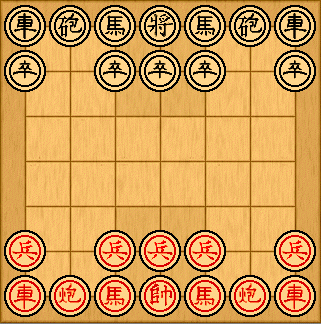

Xiangqi on a 7x7 board, without Elephants and Mandarins. The object is to checkmate the opponent’s General by attacking it so that it has no safe positions to move to. It’s also a win to stalemate your opponent so that he can’t move — this usually only happens when a player is reduced to a lone king. A player may not force a repetition of moves. Generals cannot face each other on a file with no intervening pieces. The 3 x 3 boxes at the top and bottom of the board are the Generals’ imperial palaces or fortresses. The Generals may not leave their fortresses. Chariots are the most valuable pieces. The Horse is less valuable than the Cannon in the opening, but becomes stronger as the game progresses. The Cannons are effective positioned behind friendly pawns. MiniXiangqi was introduced by S. Kusumoto, in 1973. There exists a MiniXiangqi association in Japan. Four game examples between human players are provided.
Endgames properties: A lone General can be mated (remember that checkmate and stalemate both win, and Generals cannot face each other a file with no intervening pieces) by General and Soldier, General and Horse, or General and Chariot.
Soldier/Pawn (zu/tsut, bing/ping = foot soldier) Soldiers can move forward left and right, immediately from the beginning (unlike in normal Xiangqi).
Horse/Knight (ma = horse)
Horses move like a Knight in Chess, except that they can’t jump over other pieces. They step outward on a row or column, then diagonally outward one step. If something is adjacent to a Horse on a row or column, it can’t move in that direction.
Chariot/Rook (ju/kui = chariot)
Chariots move like the Rook in Western Chess, that is, any number of squares along a row or column. The Chariots are initially positioned in the corners.
Cannon (pao = cannon)
Cannons move like Chariots/Rooks, by sliding any number of squares along a row or column, but they can capture an enemy only if there is another piece (of either side) in between. Thus to capture they leap over the intervening piece and land on the enemy piece, like a cannonball. One account of Xiangqi dates the introduction of the cannon at 839 A.D.
General/King (jiang/cheung = general, shuai/sui = general)
The General is confined to the fortress and can only move a step at a time horizontally or vertically. It also has the special power to threaten an enemy General across the board along an open column. For this reason, it is not permitted to make a move that leaves the two Generals facing each other with nothing in between. The object of the game is to checkmate the opponent’s General. The General is positioned in the middle.
Alternative variants
MiniXiangqi can also be played with promotion. The Soldier promotes, optionally, when moving up to the 6th or 7th rank.
MiniXiangqi can also be played with two Leopards each, positioned at b1/b7, f1/f7, with the Cannons before them at the second rank. The Leopard steps orthogonally 1 square or captures by jumping diagonally two squares. Captures only diagonally. (A jumping Leopard that can also move diagonally would win immediately by moving to e3, threatening mate on two squares.)
References
Pritchard, D.B. (2007). The Classified Encyclopedia of Chess Variants (editor: J. Beasley). Biddle’s Ltd, King’s Lynn.
Article in Eteroscacco 86/88, Aprile-dicembre 1999.
• You can download my free MiniXiangqi program here (updated 2011-04-12), but you must own the software Zillions of Games to be able to run it (I recommend the download version).
• Don’t miss my other chess variants.
© M. Winther, 2011 April